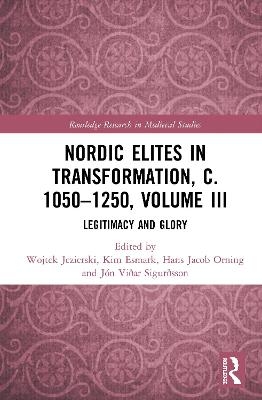
Nordic Elites in Transformation, c. 1050–1250, Volume III
Routledge (Verlag)
978-0-367-56281-6 (ISBN)
This book explores the practical and symbolic resources of legitimacy which the elites of medieval Scandinavia employed to establish, justify, and reproduce their social and political standing between the end of the Viking Age and the rise of kingdoms in the thirteenth century. Geographically the chapters cover the Scandinavian realms and Free State Iceland. Thematically the authors cover a wide palette of cultural practices and historical sources: hagiography, historiography, spaces and palaces, literature, and international connections, which rulers, magnates or ecclesiastics used to compete for status and to reserve haloing glory for themselves. The volume is divided in three sections. The first looks at the sacral, legal, and acclamatory means through which privilege was conferred onto kings and ruling families. Section Two explores the spaces such as aristocratic halls, palaces, churches in which the social elevation of elites took place. Section Three explores the traditional and novel means of domestic distinction and international cultural capital which different orders of elites – knights, powerful clerics, ruling families etc. – wrought to assure their dominance and set themselves apart vis-à-vis their peers and subjects. A concluding chapter discusses how the use of symbolic capital in the North compared to wider European contexts.
Wojtek Jezierski is Associate Professor, History of Ideas, School of Historical and Contemporary Studies, Södertörn University, Stockholm and the Department of Historical Studies, University of Gothenburg. Kim Esmark is Associate Professor of Medieval History at Department of Communication and Arts at Roskilde University. Hans Jacob Orning is Professor of Medieval History at Department of Archaeology, Conservation and History at University of Oslo. Jón Viðar Sigurðsson is Professor of Medieval History at the Department of Archaeology, Conservation and History at the University of Oslo.
Introduction: Nordic Elites in Transformation, c. 1050–1250: Legitimacy and Glory Section 1: Glorifying Kings 1. Canonizing Kings: Nordic Royal Hagiography as Legitimation and Glorification 2. Prosperity and Peace: Glorification of Rulers in Medieval Scandinavia 3. Kings, Gods, Poets, and Priests: Varieties and Transformations of Circuits of Charismatic Legitimation in Norway 4. Legitimizing Royal Power in Medieval Scandinavian Laws Section 2: Spaces of Elevation 5. Building Glory: Elite Palaces in Early and High Medieval Scandinavia 6. Glory and Legitimation in the Aristocratic Hall 7. Elite Soldiers of Christ: Elevating the Secular Elite on Danish Church Walls, Twelfth to Thirteenth Centuries Section 3: Elevating Social Orders 8. Moderation and Restraint During Conflict as Ideal Behavior in High Medieval Scandinavia and Iceland 9. Father and Son, Brother and Friend: The Papal Curia and the Status of the Nordic Ecclesiastical Elite 10. Travels, Translations, and Cultural Brokerage: Courtly Literature as a Means of Elite Legitimation in Thirteenth-Century Norway 11. Legitimation Through Narrative: Glorious Pasts as Arguments in Political Discourse 12. "Legitimation and Its Problems: The Sagas and the Icelandic Elite in the Thirteenth Century 13. Postscript
| Erscheinungsdatum | 08.10.2020 |
|---|---|
| Reihe/Serie | Routledge Research in Medieval Studies |
| Zusatzinfo | 3 Tables, black and white; 16 Halftones, black and white; 16 Illustrations, black and white |
| Verlagsort | London |
| Sprache | englisch |
| Maße | 152 x 229 mm |
| Gewicht | 589 g |
| Themenwelt | Geschichte ► Allgemeine Geschichte ► Mittelalter |
| Geisteswissenschaften ► Geschichte ► Regional- / Ländergeschichte | |
| Geschichte ► Teilgebiete der Geschichte ► Kulturgeschichte | |
| ISBN-10 | 0-367-56281-2 / 0367562812 |
| ISBN-13 | 978-0-367-56281-6 / 9780367562816 |
| Zustand | Neuware |
| Informationen gemäß Produktsicherheitsverordnung (GPSR) | |
| Haben Sie eine Frage zum Produkt? |
aus dem Bereich


